|
Introduction
by Dan Ricciardi
 Before
Rotman's, Wendy's and Culpepper's, Whittall was the name that dominated
this quaint neighborhood in South Worcester. Before
Rotman's, Wendy's and Culpepper's, Whittall was the name that dominated
this quaint neighborhood in South Worcester. 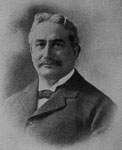 Matthew
Whittall was a British born businessman with a vision. In the midst of
the industrial revolution in the United States he decided to join the
bandwagon by building his own industrial complex in along the Middle River
in Worcester. (See also factory complex of Washburn
and Moen) At that time Worcester was very different from the city
that we know today. Without the highway system or even the automobile
the city consisted of what was, in a sense, a series of small, self-sustaining
villages. Each village existed for a specific purpose and, more often
than not, was extremely homogenous in terms of ethnic groups. When Whittall
committed to constructing his mill with it he ushered in a new village,
a British enclave in the shadow of a Catholic institution on the hill.
Not having access to automobiles, the village developed around work in
Whittall's factories. Matthew
Whittall was a British born businessman with a vision. In the midst of
the industrial revolution in the United States he decided to join the
bandwagon by building his own industrial complex in along the Middle River
in Worcester. (See also factory complex of Washburn
and Moen) At that time Worcester was very different from the city
that we know today. Without the highway system or even the automobile
the city consisted of what was, in a sense, a series of small, self-sustaining
villages. Each village existed for a specific purpose and, more often
than not, was extremely homogenous in terms of ethnic groups. When Whittall
committed to constructing his mill with it he ushered in a new village,
a British enclave in the shadow of a Catholic institution on the hill.
Not having access to automobiles, the village developed around work in
Whittall's factories.
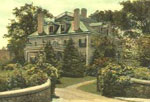 As
the factory owner and operator Whittall lived out the role as "lord
of the village" in a sense. With this, he also had his castle. On
the plot of land that is now a shopping plaza was the Whittall Residence.
An impressive mansion with carefully manicured grounds, an entrance gate
and a long driveway, the structure gave off an air of power and wealth.
For some it may have been an inspiration. If they worked hard perhaps
someday they could have a place like this. For others it could have a
matter of social order. Just as the landscaping and garden contributed
to the beauty and success of the residence, the families and the workers
contributed to the success of the community. Above all, however, it was
a matter of pride. While they did not live there, the Whittall residence
was theirs; it was their village's centerpiece. With this, however, Whittall
developed an obligation to his employees and the residents of the village.
He needed to assure, though his wealth, that they were well taken care
of and their needs were attended to. This "noblesse oblige"
was evident through Whitall in his efforts to build up a community. As
the factory owner and operator Whittall lived out the role as "lord
of the village" in a sense. With this, he also had his castle. On
the plot of land that is now a shopping plaza was the Whittall Residence.
An impressive mansion with carefully manicured grounds, an entrance gate
and a long driveway, the structure gave off an air of power and wealth.
For some it may have been an inspiration. If they worked hard perhaps
someday they could have a place like this. For others it could have a
matter of social order. Just as the landscaping and garden contributed
to the beauty and success of the residence, the families and the workers
contributed to the success of the community. Above all, however, it was
a matter of pride. While they did not live there, the Whittall residence
was theirs; it was their village's centerpiece. With this, however, Whittall
developed an obligation to his employees and the residents of the village.
He needed to assure, though his wealth, that they were well taken care
of and their needs were attended to. This "noblesse oblige"
was evident through Whitall in his efforts to build up a community.
To deal with his own
spiritual needs, as well as those of the village, he donated a significant
amount of money for the construction of St. Matthew's
Episcopal Church. Directly across the street from Whittall's home,
the church was a satellite congregation to All
Saints Church in downtown Worcester. While "officially"
named after the apostle Matthew, Matthew Whittall undoubtedly had some
influence in naming process. The next essential part of the community
was a school. The Cambridge Street School was next door to Whittall's
residence and focused on educating the younger members of the community
on how to be Americans. In the shadow of Whittall's gardens, the students
were permitted once a year to walk through them.
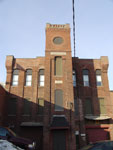 Whittall's
obligation to provide an example undoubtedly influenced this factor, as
well as his decision not to put a fence up surrounding the lands. With
the factory, school, church and "castle" in place, the workers
made their homes on land immediately surrounding these destinations. While
humble, each residence was in close proximity to everything. Life flowed
through the neighborhood in a way much different than cars speeding through
it. Everyone depended on each other and, essentially, they all lived the
same way. In the morning machine operators in the mills walked to work,
children walked to school and, on weekends, the entire family would walk
to church together. Meals were always shared together as everyone was
so close by. The community was also incredibly strong. Your neighbors
were your associates, classmates and, in some cases, family. These were
the people that you lived your life with. It is a far cry from urban life
today. All in all the community was shaping up nicely, with the exception
of one other important building. While residents had a place to work,
worship and be educated, the neighborhood was badly in need of a library. Whittall's
obligation to provide an example undoubtedly influenced this factor, as
well as his decision not to put a fence up surrounding the lands. With
the factory, school, church and "castle" in place, the workers
made their homes on land immediately surrounding these destinations. While
humble, each residence was in close proximity to everything. Life flowed
through the neighborhood in a way much different than cars speeding through
it. Everyone depended on each other and, essentially, they all lived the
same way. In the morning machine operators in the mills walked to work,
children walked to school and, on weekends, the entire family would walk
to church together. Meals were always shared together as everyone was
so close by. The community was also incredibly strong. Your neighbors
were your associates, classmates and, in some cases, family. These were
the people that you lived your life with. It is a far cry from urban life
today. All in all the community was shaping up nicely, with the exception
of one other important building. While residents had a place to work,
worship and be educated, the neighborhood was badly in need of a library.
In his 1909 article
in Worcester Magazine, City Librarian Robert K. Shaw extolled the
virtues of Branch Libraries. While Worcester
had a well-established main branch, without automobiles it was rather
difficult for residents of the various villages that made up Worcester
to utilize the full potential of its collection. Therefore the city, through
the efforts of Mayor James Logan, was able to secure a grand from Andrew
Carnegie for the construction of a number of branch libraries throughout
the city. The South Worcester Branch Library was one of three Carnegie
Libraries and was built chiefly to serve the surrounding community. The
land, donated by Matthew Whittall, is another exemplification of his devotion
and obligation to the people of South Worcester.
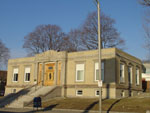 The
addition of the library to the community was an important one for the
people. It was centrally located and easily accessible and provided an
escape through literature that everyone could enjoy. In the 1914 Worcester
Magazine article announcing the opening and dedication of the library
a number of references were made to children rushing in and crowding the
Children's room after school. Undoubtedly this was important in that it
helped their continuing education. In addition to providing another outlet,
it helped to further the intellectual development of the community thus
serving Worcester on a number of fronts. As time passed the community
continued to boom. Generations of families worked in the Whittall factories,
some even inheriting jobs from their other relatives. Even after Whittall's
death his legacy and "noblesse oblige" lived on through his
family. One such example is their furnishing of St. Matthew's with rather
impressive Tiffany Windows. While production in the factories continued
on strong through World War II, however, the dynamics of the community
and its people were changing, commencing the slow degradation of what
was once a strong self-sustained community. The
addition of the library to the community was an important one for the
people. It was centrally located and easily accessible and provided an
escape through literature that everyone could enjoy. In the 1914 Worcester
Magazine article announcing the opening and dedication of the library
a number of references were made to children rushing in and crowding the
Children's room after school. Undoubtedly this was important in that it
helped their continuing education. In addition to providing another outlet,
it helped to further the intellectual development of the community thus
serving Worcester on a number of fronts. As time passed the community
continued to boom. Generations of families worked in the Whittall factories,
some even inheriting jobs from their other relatives. Even after Whittall's
death his legacy and "noblesse oblige" lived on through his
family. One such example is their furnishing of St. Matthew's with rather
impressive Tiffany Windows. While production in the factories continued
on strong through World War II, however, the dynamics of the community
and its people were changing, commencing the slow degradation of what
was once a strong self-sustained community.
Architectural
Forms of South Worcester's British Enclave by Kristen Rohde
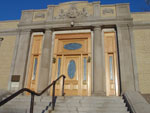 The
Carnegie Library, built in 1913 beside St. Matthew's Episcopal Church,
is a true "sacred space" in its own right. This structure is
an example of Neoclassical
style giving a sensation of seamless horizontality through a single story
and functional basement design, which creates a rectangular box form envelope.
The yellow brick, limestone railings and granite promenade place emphasis
on an "elevated air" among the redbrick industrial structures
and Cambridge School which lay in close proximity. Although the structure
can be classified on the smaller end of the scale in stature, it certainly
lacks nothing in the realm of distinction as a symbol of "higher
intellectual learning and discovery." The simple "Tuscan-style"
columns frame the ornamental façade and create a clean sense of
architectural beauty, complete with an inviting and grand staircase engaging
curious eyes upward towards the entrance, which resides off the road in
a splendidly elevated fashion. The monogram "WL' (Worcester Library)
appears in a classic coat of arms bas-relief which during the Renaissance
was labeled a cartouche, "perhaps bearing a family seal, a symbol
of emphatic identity of a classical Palazzo façade, typical of
the 16th century in Rome" (Stokstad 704). The cartouche is bordered
by winding and intricately carved garland, all quintessential components
of the aesthetically pleasing and carefully designed horizontal frieze. The
Carnegie Library, built in 1913 beside St. Matthew's Episcopal Church,
is a true "sacred space" in its own right. This structure is
an example of Neoclassical
style giving a sensation of seamless horizontality through a single story
and functional basement design, which creates a rectangular box form envelope.
The yellow brick, limestone railings and granite promenade place emphasis
on an "elevated air" among the redbrick industrial structures
and Cambridge School which lay in close proximity. Although the structure
can be classified on the smaller end of the scale in stature, it certainly
lacks nothing in the realm of distinction as a symbol of "higher
intellectual learning and discovery." The simple "Tuscan-style"
columns frame the ornamental façade and create a clean sense of
architectural beauty, complete with an inviting and grand staircase engaging
curious eyes upward towards the entrance, which resides off the road in
a splendidly elevated fashion. The monogram "WL' (Worcester Library)
appears in a classic coat of arms bas-relief which during the Renaissance
was labeled a cartouche, "perhaps bearing a family seal, a symbol
of emphatic identity of a classical Palazzo façade, typical of
the 16th century in Rome" (Stokstad 704). The cartouche is bordered
by winding and intricately carved garland, all quintessential components
of the aesthetically pleasing and carefully designed horizontal frieze.
 It
is only about a three minute walk to the Cambridge School, which playfully
peeked above the Whittall's grand estate, complete with its naturally
landscaped "English-style" gardens bursting with exquisite flowers.
The Library's small yet economically efficient construction can be summed
up in the description, "understated elegance." It was inviting
and comfortable for those who wished to take their minds to "the
next level" as well as neighboring college students and inventors
who also frequented the new establishment in hopes of bettering the world
around them. Carnegie quoted, "Through books our world is enlarged
and by these new friends who are introduced to us through the printed
page, purifying and making clear our ideals" (Worcester Magazine,
1914: 90). Here, the community could gather including; children, women
and the "promising youth" who were then able to meet with "more
senior" members of the area and "share their mutual love of
knowledge with one another, resulting in positive and unifying encounters"
(Shaw). After receiving notice from ex-Mayor James Logan, philanthropist
and steel-giant Andrew Carnegie felt that "The Heart of the Commonwealth"
was indeed, ready to receive not one, but three fine satellite establishments-
all of which were dedicated on the same day! It
is only about a three minute walk to the Cambridge School, which playfully
peeked above the Whittall's grand estate, complete with its naturally
landscaped "English-style" gardens bursting with exquisite flowers.
The Library's small yet economically efficient construction can be summed
up in the description, "understated elegance." It was inviting
and comfortable for those who wished to take their minds to "the
next level" as well as neighboring college students and inventors
who also frequented the new establishment in hopes of bettering the world
around them. Carnegie quoted, "Through books our world is enlarged
and by these new friends who are introduced to us through the printed
page, purifying and making clear our ideals" (Worcester Magazine,
1914: 90). Here, the community could gather including; children, women
and the "promising youth" who were then able to meet with "more
senior" members of the area and "share their mutual love of
knowledge with one another, resulting in positive and unifying encounters"
(Shaw). After receiving notice from ex-Mayor James Logan, philanthropist
and steel-giant Andrew Carnegie felt that "The Heart of the Commonwealth"
was indeed, ready to receive not one, but three fine satellite establishments-
all of which were dedicated on the same day!
The addition of the
South Worcester Library on property allotted by Matthew Whittall and Alfred
Thomas, aided the progress of intellectual growth in this British immigrant
community by assuming a "mediator" role between "immigrant
parents" and their children who were essentially "American citizens-in-training."
The library also injected a sense of pride and identity into the community
as well. The Renaissance/ Neo-classical styles in which this structure
was derived, evokes a sense of superiority while also displaying a Roman
"temple like" reverence for learning. Imagine this building
facing the front of Whittall's grand estate- of course it had to blend
cohesively with the classical style of the mansion, creating a sense of
balance and harmony among the closely positioned "all inclusive"
(church, school, factory, library and mansion) buildings of the area.
The Cambridge School boasts a simplistic redbrick design and is strikingly
similar in appearance to the nearby Whittall factory buildings.
 In
contrast to the library, the three building's "main structure"
is comprised of three stories, complete with a fully functional and decorative
Mansard
roof whose peaks emphasize the verticality of the structure. Cambridge's
large windows are arranged in a simple yet pronounced plan emitting an
aura belonging to that of a "work establishment," much like
the adjacent mills in which an environment of labor was also fostered.
The front building facing Cambridge Street bears a gold and green sign
and lattice faux porch in a Neo-Victorian style, in attempts to intermingle
with the more formal architecture of the library and Whittall estate.
The stanchions holding up the porch are about as close as this building
gets to possessing "classically configured columns." Although
the design is clearly more "basic" in nature than that of the
Carnegie Library, lacking lavish granite and limestone accents, it fit
the qualifications necessary for a communal "utilitarian school."
The school worked to further the development and "Americanization"
of this "thickly populated suburban district of South Worcester,"
as displayed by this particular British enclave. This complex which worked
to promote "universal education" was certainly situated in an
intriguing geographic location. In
contrast to the library, the three building's "main structure"
is comprised of three stories, complete with a fully functional and decorative
Mansard
roof whose peaks emphasize the verticality of the structure. Cambridge's
large windows are arranged in a simple yet pronounced plan emitting an
aura belonging to that of a "work establishment," much like
the adjacent mills in which an environment of labor was also fostered.
The front building facing Cambridge Street bears a gold and green sign
and lattice faux porch in a Neo-Victorian style, in attempts to intermingle
with the more formal architecture of the library and Whittall estate.
The stanchions holding up the porch are about as close as this building
gets to possessing "classically configured columns." Although
the design is clearly more "basic" in nature than that of the
Carnegie Library, lacking lavish granite and limestone accents, it fit
the qualifications necessary for a communal "utilitarian school."
The school worked to further the development and "Americanization"
of this "thickly populated suburban district of South Worcester,"
as displayed by this particular British enclave. This complex which worked
to promote "universal education" was certainly situated in an
intriguing geographic location.
Standing in front
of it, one was able to catch a sight of the library in its entire splendor
and steal a glimpse of Holy Cross, Fenwick in particular, as a separate
entity and goal to strive for, although it was reserved only for the elite
Catholic students of the time. "It is not a distant prospect of Eton
College that salutes the eye, turned towards yonder southern hillside,
but rather one of Holy Cross College, up to which many of Miss George's
boys cast aspiring glances, cherishing ambitions which she was wont to
foster and further" (Worcester Magazine, 1902:104). The Cambridge
School was a communal space the people of South Worcester were sincerely
proud of. Recall that during this time (1890's to WWI), it was unusual
for a family to up and relocate, as most people formed firm roots in their
hometown and left their mark by way of subsequent generations. Both the
Carnegie Library and Cambridge School in their architectural form and
important function, served as extremely central components of this "industrially
based" ethnic neighborhood at the turn of the 20th century in the
area of South Worcester, Massachusetts.
Schools,
Libraries and Women by Jacquelyn McEttrick
A study of the people
within the Carnegie library and Cambridge Street school exemplifies widespread
ideas and ideals about education and the role of women. The late 19th
century saw school reform due largely to the demand for an educated citizenry
to staff the positions created in the American industrial expansion exemplified
by Whittall's mills (Brinkley 526-8). The state of Massachusetts, in particular,
placed special emphasis on the value of education and the importance of
making education available to all. (Indeed, in 1647, Massachusetts had
passed a law that required each town to support a public school, the first
state to do so [Brinkley 88].) Massachusetts at this time expanded its
public school system to provide more specialized training and include
more scientific knowledge in its curriculum (Brinkley 523).
The reform also reflected
political realities for Worcester, which like many other American cities
was experiencing huge waves of immigration in the second half of the 19th
century. The city was clearly divided into neighborhoods of immigrants
hailing from similar homelands, such as the English enclave of South Worcester.
Such communities seldom required their inhabitants to leave, at least
not on a daily basis. Indeed, the South Worcester neighborhood of English
settlers contained its own factories (the Whittall Mills), family homes
and a school that provided for its residents.
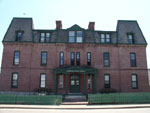 In
1875, this school became known as the Cambridge Street school (formerly,
South Worcester school) and came under the charge of "Miss Carrie
A. George." Ms George taught at the school until her death on June
20, 1892. Her life paralleled the lives of many of her fellow teachers
at the end of the 19th century when women were sought after as educators,
one of the very few professional jobs open to them. Indeed, it is estimated
that as much as ninety percent of all professional women were involved
in the field of education (Brinkley 581). Carrie George had been educated
in New Hampshire before coming to Worcester. She never married, as was
custom with many professional women of her day who clearly saw their lives
as being a career of marriage or a working career. It was not considered
appropriate for women of the middle-class (most teachers fell into this
category) to have both a family and a career outside the home (Brinkley
660-2). Lower class women, however, often worked as maids, laundresses,
and seamstresses apparently without being considered negligent mothers. In
1875, this school became known as the Cambridge Street school (formerly,
South Worcester school) and came under the charge of "Miss Carrie
A. George." Ms George taught at the school until her death on June
20, 1892. Her life paralleled the lives of many of her fellow teachers
at the end of the 19th century when women were sought after as educators,
one of the very few professional jobs open to them. Indeed, it is estimated
that as much as ninety percent of all professional women were involved
in the field of education (Brinkley 581). Carrie George had been educated
in New Hampshire before coming to Worcester. She never married, as was
custom with many professional women of her day who clearly saw their lives
as being a career of marriage or a working career. It was not considered
appropriate for women of the middle-class (most teachers fell into this
category) to have both a family and a career outside the home (Brinkley
660-2). Lower class women, however, often worked as maids, laundresses,
and seamstresses apparently without being considered negligent mothers.
The obituary article
in the September 1902 edition of the Worcester Magazine for Ms
George reveals the virtues considered important for a school teacher at
this time. For example, Ms George is remembered and celebrated for her
family' s honorable past, including a grandfather who served in the Revolutionary
war and a mother and a father who hailed from the great state of Massachusetts
originally and had considerable family ties back in Britain on her mother's
side (Worcester Magazine, 1902:102-6). Such an extensive review
of Ms George's ancestors reveals the belief of many 19th-century people
that the virtues and vices of one's predecessors could be passed through
a family. As a political unit, the family was highly operative in interactions
at this time- operative both as constraint and facilitator. Essentially,
Ms George was seen as possessing female virtues; she "loved her work
and her pupils, and in return they loved her" (Worcester Magazine,
1902:104). Ms George could still exercise maternal values even without
a husband and children of her own; she had her school and her students
and she devoted her life to them.
 An
example of the reciprocal relationship among economic and social patrons
and the leaders of education, such as Ms George, was the annual walk through
the gardens at the Whittall mansion, located right beside the Cambridge
Street school, that Ms George started during her tenure at the school.
Ms George had suggested such an excursion to Mr. Whittall's as an enjoyable
and inspirational activity for her pupils. Indeed, this annual tour provided
the students with an image of what hard work brings (namely, success similar
to that of Mr. Whittall's) and also the importance of contributing to
the community, again as exemplified by Mr. Whittall's generosity in allowing
the students to stroll his gardens. Concluding the Worcester Magazine
tribute article is a sentence that certainly applied to Ms Carrie A. George,
but also to the wider population of female educators in turn-of-the-century
America: "She will ever be the type and ideal of a good teacher and
a noble woman" (Worcester Magazine, 1902:106). The choice
of words in this sentence is very deliberate and telling of the fact that
American women in general, and American teachers in particular, were expected
to produce successful, patriotic and loyal American citizens. Thus, the
mention of Ms George's grandfather as a veteran of the Revolutionary War
at the beginning of the article has additional meaning, since it was men
like her grandfather that Ms George was expected to produce through her
teaching. An
example of the reciprocal relationship among economic and social patrons
and the leaders of education, such as Ms George, was the annual walk through
the gardens at the Whittall mansion, located right beside the Cambridge
Street school, that Ms George started during her tenure at the school.
Ms George had suggested such an excursion to Mr. Whittall's as an enjoyable
and inspirational activity for her pupils. Indeed, this annual tour provided
the students with an image of what hard work brings (namely, success similar
to that of Mr. Whittall's) and also the importance of contributing to
the community, again as exemplified by Mr. Whittall's generosity in allowing
the students to stroll his gardens. Concluding the Worcester Magazine
tribute article is a sentence that certainly applied to Ms Carrie A. George,
but also to the wider population of female educators in turn-of-the-century
America: "She will ever be the type and ideal of a good teacher and
a noble woman" (Worcester Magazine, 1902:106). The choice
of words in this sentence is very deliberate and telling of the fact that
American women in general, and American teachers in particular, were expected
to produce successful, patriotic and loyal American citizens. Thus, the
mention of Ms George's grandfather as a veteran of the Revolutionary War
at the beginning of the article has additional meaning, since it was men
like her grandfather that Ms George was expected to produce through her
teaching.
Ms George was not
able to enjoy the expansion of the Worcester library system that similarly
occurred as a result of the increased demand for learning in the wake
of the industrial expansion and that played a key role in the creation
of American citizens. In 1913, Andrew
Carnegie, a man who made his fortune as a result of the steel industry,
financed the building of three new libraries in Worcester. Worcester was
not unique in this gift of libraries from Andrew
Carnegie. Indeed, Carnegie was a devoted philanthropist throughout
his life. In 1901, Carnegie even wrote the book The
Gospel of Wealth, in which he states that wealthy citizens should
use their money to better the community. Carnegie continues by stating
that a wealthy man is actually an agent for his poorer peers. Carnegie
considered himself to be an agent who could help the poor help themselves
and so he donated much of his money to the construction of libraries throughout
the country (several thousand in total) (Brinkley 488-89).
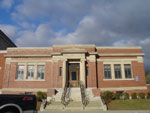 One
of the libraries he donated in Worcester was erected on Southbridge Street
on a parcel of land donated by Mr. Whittall and Mr. Thomas, a prosperous
supervisor in the Whittall Mills. New libraries were greatly needed in
Worcester, as attested by a 1909 article in the Worcester Magazine
that described how the prosperous city of Worcester had outgrown its
one previous library and was desperately in need of branches in other
neighborhoods (Shaw 178-82). Quinsigmond Village also saw a Neoclassical
library, this one in red brick. The inclusion of a library within the
South Worcester community spoke to the status of the area and to the status
of the neighborhood's wealthy benefactor, Matthew Whittall. One
of the libraries he donated in Worcester was erected on Southbridge Street
on a parcel of land donated by Mr. Whittall and Mr. Thomas, a prosperous
supervisor in the Whittall Mills. New libraries were greatly needed in
Worcester, as attested by a 1909 article in the Worcester Magazine
that described how the prosperous city of Worcester had outgrown its
one previous library and was desperately in need of branches in other
neighborhoods (Shaw 178-82). Quinsigmond Village also saw a Neoclassical
library, this one in red brick. The inclusion of a library within the
South Worcester community spoke to the status of the area and to the status
of the neighborhood's wealthy benefactor, Matthew Whittall.
Transformation
and the Present by Dan Ricciardi
With the widespread
adoption of the automobile the dynamics of the community changed dramatically.
While quite expensive at first, as time progressed it became more and
more affordable to buy a car. It was a wonderful way to travel, indeed,
but now members of the community were no longer tied down to their own
village. They had the ability to get up and go whenever they desired.
While it was a trend followed by most of the country, it challenged the
strong cohesiveness of the community that had characterized it many years
before. As the population of the city grew so did the opportunity for
new jobs. Residents of South Worcester now had other job opportunities
aside from working in the Whittall Mills. With this, residents left the
community for different jobs and some even moved entirely. While production
was ramped up for World War II, the post-war years proved too much of
a strain for the Whittall Mills to handle. The changing trends in local
economies placed the New England Textile industry into a state of general
malaise. It became more and more expensive to handle the day to day expensive
of producing carpets and increased pressure was placed upon the factory
to produce. While the Whittall family attempted to breathe life into the
dying factory through the purchase of new machinery to upgrade the mills
nature was not on its side. A bad storm caused the flooding of the Middle
River, by which the Whittall mills were built, and destroyed most of the
machines. By 1957, almost eighty years after Matthew Whittall's first
factory opened in 1880, the Whittall
Anglo-Persian Carpet Company went out of business.
Without the Whittall
Carpet Mills the community slowly began to drift apart. For the construction
of Route 290 the City of Worcester took the Whittall's private residence
by eminent domain and demolished the building. To the British residents
of the community this was a horrible blow. The Whittall residence had
always been the prized possession of the village. It was a symbol of strength,
power and wealth. While in its later years it had lost quite a bit of
the splendor of its earlier days, it was still a dominant presence in
the community. After its demolition the remainder of the land not used
for the highway was sold for the construction of an A&P Supermarket,
a replacement for some of the smaller shops also lost to the highway.
As time went on more and more people left. The highway and other changes
for the sake of "modernity" began to cut the community apart.
The congregation at St. Matthew's slowly shrank and, in the late twentieth
century, both the Cambridge Street School and South Worcester Library
closed its doors. In search of new jobs many of the British residents
of South Worcester moved elsewhere. Today Whittall's factories are a furniture
store, the Cambridge Street School is low-income housing and the library
has been recently sold and is undergoing renovations to become condominiums.
While all of these important buildings in South Worcester are listed on
the National Register of Historic Places, their condition and use today
somehow mutes their importance in the development of an important part
of Worcester's past and the adjustment of an important immigrant group.
Amazingly, however, there are no markers signifying the historical importance
of these buildings. While the dynamics of the South Worcester Community
have changed dramatically its legacy still lives on in role that it has
played in the development of Worcester.
Bibliography
Batty, Brian. Personal
Interview, February 2003.
Brinkley, Alan. American History: A Survey. New York: McGraw-Hill,
Inc., 1995.
Knowlton, Elliot B, and Gibson-Quigley, Sandra. Worcester's Best: A
Guide to the City's Architectural Heritage (Second Ed., Expanded and
Revised) Preservation Worcester: Worcester, 1996.
Shaw, Robert K. "Our Public Library." Worcester Magazine,
12 (May 1909): 178-182.
Stokstad, Marilyn. Art History (Second Ed.) Vol. 2. New York: Prentice
Hall Inc., and Harry N. Abrams, Inc., Publishers, 2002.
Whiffen, Marcus, American Architecture since 1780: A Guide to the Styles,
Rev. ed. Cambridge Mass. MIT Press, 1992.
"Whittall's Anglo-Persian Rugs." http://www.orientalrugs.com/wwwboard/messages/2609.html.
"Miss Carrie A. George, Teacher." Worcester Magazine,
IV No. 3 (September 1902): 102-6.
"The Carnegie Branch Libraries," Worcester Magazine Volume
(April 1914): 89-91.
"An Object Lesson in Co-operation," Worcester Magazine
Volume (DATES):141-43
|

